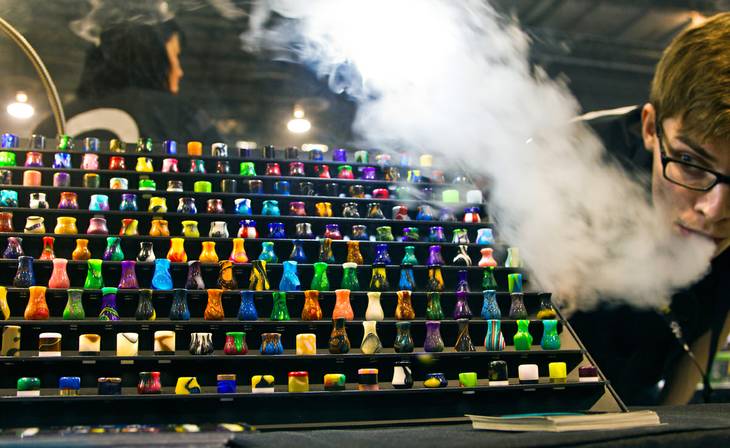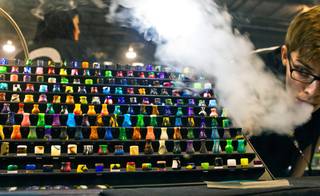When they were first mass produced, e-cigarettes and vaping products formed an industry widely considered to be a dud in the United States. Popularized in China in the early 2000s, they launched with little fanfare in the U.S. in the past decade as a less harmful alternative to tobacco.
But in recent years, the battery-powered vaporizer industry has taken off. It was worth $10 billion in 2017, and market research estimates it will reach $34 billion by 2021, $46 billion by 2023 and $64 billion by 2025.
As neighboring states have thrown in massive taxes and regulations to combat large vaping corporations from growing too much, many companies are moving to Las Vegas.
“This city gives people a well-rounded life, and from a traffic perspective, everybody’s time is being used more efficiently,” says Billy Wilson, CEO of online retail and wholesale supplier E-Cig Distributors. “It’s great for business because it’s easy to convince clients to come to Las Vegas for meetings and conventions. You don’t have to twist too many arms.”
Wilson’s company, which distributes almost 10 million e-cig products around the world each year, is one of more than a dozen vaping mega-companies to move from California and Washington to the Las Vegas Valley as regulations and future proposed laws have hampered the industry in those states, starting in 2016. While each company’s reasons for moving here vary, interviewed CEOs cited California’s Prop 56—which increased consumer taxes on tobacco and vaping products by almost 230 percent starting in 2017—and Washington’s House Bill 2165, which proposes to hike up such taxes by more than 60 percent, as contributing factors for their migration to the Valley.
After moving five times around Orange County from 2012 to 2017, Wilson convinced 28 of E-Cig Distributors’ then-40 employees to join him in a full-scale move to Las Vegas last March. Operating here for more than a year, Wilson says his company is thriving more than ever in a state that’s “much more open to business.” He credited local and state economic departments for helping ECD make a “relatively seamless” move.
“We had 45 days to identify a building, pack everybody up and make the move actually happen,” he says. “We finally shut down operations in Orange County on a Thursday, and we were open in Las Vegas the next Monday.”
Facts and figures about e-cigarettes and vaping products
• Vaping products produce an aerosol by heating a flavored liquid that’s inhaled by users into their lungs. The battery-powered products come in varying shapes and sizes and are known as “e-cigs,” “mods” and “vape pens” among other nicknames.
• While vaping products save users from tar and other cancer-causing substances found in tobacco and marijuana cigarettes, vape juices can still include harmful chemicals like nicotine, diacetyl and — for weed vapes — THC.
• The vaping industry was worth $10 billion in 2017, and market research estimates it will reach $34 billion by 2021, $46 billion by 2023 and $64 billion by 2025.
• San Francisco-based Juul has 54 percent market share in the industry, and federal officials expect the brand to continue growing among both adults and underage users.
• (Sources: U.S. Centers for Disease Control and Prevention, U.S. Dept. of Health and Human Services, Nielsen)
Jimmy Chen, CEO of Uvaper Wholesale, moved 20 of his 50 employees this year from Kent, Washington, for the chance at a more centrally located distribution headquarters in Las Vegas. Chen, like Wilson, says the move made sense among other reasons because he’s able to more easily attract clients to visit Las Vegas than the Pacific Northwest. Chen says he hopes to hire an additional 30 employees at Uvaper’s Las Vegas headquarters by the end of the year to keep up with growing business.
Vape industry employees, like Corben Madden, ECD’s chief technology officer, says their dollar also goes much further in the Valley, thanks to lower home and rental rates and no state income tax.
“I save a ton of money on each paycheck and my taxes at the end of the year,” he says.
Wilson, Chen and Madden say diversification of the Valley’s economy also was an attractive draw. Traditionally known as a city for gambling and entertainment, the addition of professional sports teams and modern businesses such as Amazon, Postmates, Soothe and others give Las Vegas the feel of a “well-established West Coast city,” Madden says.
But while Nevada has taken a business-friendly approach to the vape industry, federal officials warn a growing number of young users may eventually lead the state to implement tax hikes similar to those in California and Washington. Of the estimated 10 to 12 million vape users in the United States, more than 2 million are underage, according to figures from the U.S. Center of Disease Control.
San Francisco-based brand Juul last month achieved 54 percent of the vape market share, according to statistics from Nielsen, thanks in part to viral videos of its users experimenting with the products on social media. Under heavy pressure, the vape giant declared its support to raise the minimum purchase age for vaping products from 18 to 21 years old and contributed $30 million to research and prevention of underage use of its products.
“Our company’s mission is to eliminate cigarettes and help the more than 1 billion smokers worldwide switch to a better alternative,” says Juul Labs CEO Kevin Burns. “At the same time, we are committed to deterring young people, as well as adults who do not currently smoke, from using our products.”
Brian King, who oversees the CDC’s Office on Smoking and Health, called the growing youth e-cigarette usage statistics “concerning,” adding that almost 60 percent of Americans who vape are also tobacco users. Despite industry marketing claims that e-cigarette products can help people stop smoking tobacco, King says evidence on vape products as healthy alternatives to traditional cigarettes is “not conclusive.” Vaping products have not been proven to help tobacco users quit, either.
“There are some people successfully quitting tobacco with e-cigarettes, but the majority of users are not,” King says. “We know e-cigarettes are safer than combustible cigarettes, but that doesn’t mean they’re safe. The science on the issue is still really mixed.”

